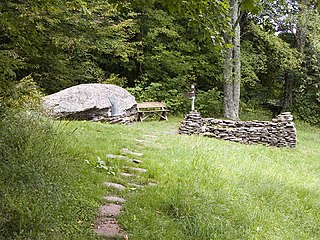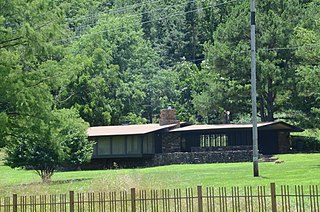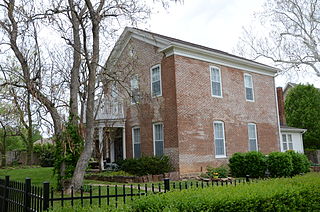
Washington County is a regional economic, educational, and cultural hub in the Northwest Arkansas region. Created as Arkansas's 17th county on November 30, 1848, Washington County has 13 incorporated municipalities, including Fayetteville, the county seat and Springdale. The county is also the site of small towns, bedroom communities, and unincorporated places. The county is named for George Washington, the first President of the United States

Fayetteville is the third-largest city in Arkansas and county seat of Washington County. The city is on the outskirts of the Boston Mountains, deep within the Ozarks. Known as Washington until 1829, the city was named after Fayetteville, Tennessee, from which many of the settlers had come. It was incorporated on November 3, 1836 and was rechartered in 1867. The four-county Northwest Arkansas Metropolitan Statistical Area is ranked 105th in terms of population in the United States with 463,204 in 2010 according to the United States Census Bureau. The city had a population of 73,580 at the 2010 Census.

Woodchuck Lodge is a historic house on Burroughs Memorial Road in a remote part of the western Catskills in Roxbury, New York. Built in the mid-19th century, it was the last home of naturalist and writer John Burroughs (1837-1921) from 1908, and is the place of his burial. The property is now managed by the state of New York as the John Burroughs Memorial State Historic Site, and the house is open for tours on weekends between May and October. The property is a National Historic Landmark, designated in 1962 for its association with Burroughs, one of the most important nature writers of the late 19th and early 20th centuries.

The Menard-Hodges Site (3AR4), is an archaeological site in Arkansas County, Arkansas. It includes two large platform mounds as well as several house mounds. It is the type site for the Menard phase, a protohistoric Mississippian culture group.
This is an incomplete list of historic properties and districts at United States colleges and universities that are listed on the National Register of Historic Places (NRHP). This includes National Historic Landmarks (NHLs) and other National Register of Historic Places listings. It includes listings at current and former educational institutions.

The University of Arkansas Campus Historic District is a historic district that was listed on the National Register of Historic Places on September 23, 2009. The district covers the historic core of the University of Arkansas campus, including 25 buildings.

The Fayetteville Historic Square, in Fayetteville, Arkansas, includes the original Fayetteville post office, the Old Bank of Fayetteville Building, the Lewis Brothers Building, the Mrs. Young Building, and the Guisinger Building. These buildings are listed in the National Register of Historic Places. There are several more recent buildings located on the Square.

The Frisco Depot in Fayetteville, Arkansas, is a railroad depot built in 1925. The last passenger trains left Frisco Depot in 1965, and starting in 2011, the depot's interior houses a Chipotle Mexican Grill. The property was listed on the National Register of Historic Places on December 8, 1988.

The Wilson Park Historic District is a historic district in Fayetteville, Arkansas, USA, located just northeast of the University of Arkansas. The district consists of several residential buildings that developed during the late 19th and early 20th Century near Wilson Park just north of Dickson Street, the city's primary entertainment district. Wilson Park Historic District includes 47 contributing buildings.

The Chi Omega Chapter House is a building built in 1927 on the campus of the University of Arkansas in Fayetteville, Arkansas. The building was listed on the National Register of Historic Places in 1995.

The Clinton House is a historic house museum at 930 West Clinton Drive in Fayetteville, Arkansas. Built in 1931, it was the first home of Bill Clinton and Hillary Rodham while they both taught at the University of Arkansas School of Law and was where they married in 1975. The house was listed on the National Register of Historic Places in 2010.

Mount Nord Historic District is a historic district in Fayetteville, Arkansas encompassing one city block with five properties. The district lies atop a rise of about 140 feet (43 m) above the surrounding area. The properties were built between 1901 and 1925 in various architectural styles, and the area was listed on the National Register of Historic Places in 1982.

Martha and Maurice Ostheimer Estate is a historic home located in West Whiteland Township, Chester County, Pennsylvania. The estate home known as "Grimmet" was designed by architect John Gilbert McIlvaine, a partner of Wilson Eyre, and built in 1924 in the Tudor Revival style. It was expanded in 1952. The house has been converted to office use. The property includes the previously listed Wee Grimmet, built about 1820, and expanded about 1929 by McIlvaine. The property also includes a contributing small stone arch bridge, a terraced landscape, and the site of a 19th-century limestone quarry and kiln. Martha Gibson McIlvain Ostheimer was one of three founders of the Herb Society of America, and her Herb Gardens west and southwest of Grimmet were well known among herbalists until 1962.

The Gregg House is a historic house at 339 Gregg Street in Fayetteville, Arkansas, near the University of Arkansas campus. It was built in 1871 and listed on the National Register of Historic Places in 1974.

Washington–Willow Historic District is a residential neighborhood of Fayetteville, Arkansas containing over one hundred historically and architecturally significant homes. Styles range from those popular in the mid-19th century through present day, predominantly Victorian, Italianate, neoclassical, and craftsman bungalows. Historically, Fayetteville leaders in business, law and education have all called the district home. The homes sit at the foot of East Mountain within the Masonic Addition, the first addition platted following incorporation.

Fitzgerald Station and Farmstead is a collection of historic buildings and structures in Springdale, Arkansas associated with the Butterfield Overland Mail Trail. Historically the site of a tavern popular with travelers heading west prior to the establishment of the Butterfield Trail, the property became a station along the route in the 1850s. Today, the property retains an original 1850s barn built as a waypoint along the route, as well as an 1870s house and associated outbuildings. It was listed on the National Register of Historic Places in May 2003.

U.S. Highway 71 is a U.S. highway that runs from Krotz Springs, LA to the Fort Frances–International Falls International Bridge at the Canadian border. In Arkansas, the highway runs from the Louisiana state line near Doddridge to the Missouri state line near Bella Vista. In Texarkana, the highway runs along State Line Avenue with US 59 and partially runs in Texas. Other areas served by the highway include Fort Smith and Northwest Arkansas.

The Adrian Fletcher Residence is a historic house at 6725 Washington Road in Fayetteville, Arkansas. It is a single-story stone and wood structure with a shallow-pitched gable roof, set near the north side of an 80-acre (32 ha) parcel of land on the south side of East Huntsville Road. It is divided roughly into three sections, consisting of the main house, an open breezeway, and a carport. Built in 1957, it is a significant early work of E. Fay Jones, a protégé of Frank Lloyd Wright; it was his first commission completed after official recognition as an architect, and it became a showcase of his work, being written up and photographed for several magazines.

The Jackson House is a historic house at 1617 North Jordan Lane in Fayetteville, Arkansas. It is a 2 1⁄2-story L-shaped brick building, three bays wide, with a cross gable roof and a single-story ell extending to the north. A single-story portico shelters the main entrance of the south-facing facade, supported by two square columns, with a balustrade above. A small round window is located in the gable end of the main facade. The east elevation (which faces the street, has two segmented-arch windows on each level. The house was built in 1866 by Columbus Jackson, whose family lineage is said to include President Andrew Jackson.

The Brill Octagon House is a historic octagon house at Capon Springs and McIlwee Roads in Capon Springs, West Virginia. It is a two-story wood-frame structure, that is actually cruciform in shape, but is given an octagonal appearance by the presence of two-story triangular porches that join the corners of the cross. The house was built about 1890 by one of a father-son pair, both named Elias Brill. The elder Brill, a more likely candidate as its builder, was a farm laborer, and was according to family lore guided in the building's design by an architect who was a summer guest at the Capon Springs Resort. The design is apparently a throwback to the briefly popular octagon house movement led by Orson Squire Fowler in the 1850s.




















